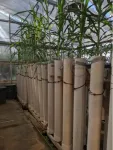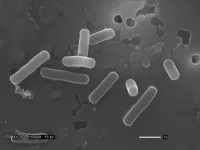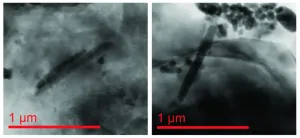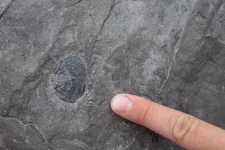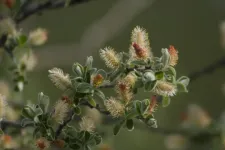(Press-News.org) A previously unknown root trait allows some cereal plants to grow deeper roots capable of punching through dry, hard, compacted soils, according to Penn State researchers, who suggest that harnessing the inherited characteristic could lead to crops better able to deal with a changing climate.
"This discovery bodes well for American and global agriculture because the trait helps corn, wheat and barley grow deeper roots, which is important for drought tolerance, nitrogen efficiency and carbon sequestration," said Jonathan Lynch, distinguished professor in plant science. "Breeding for this trait should be helpful in developing new crops for climate mitigation."
Called multiseriate cortical sclerenchyma by the researchers -- or MCS -- the phenotype is characterized by small cells with thick walls just beneath the surface of the roots. Roots with the MCS genotype have a greater concentration of lignin -- a complex organic polymer that is important in the formation of cell walls, especially in wood and bark, that lends rigidity.
More lignin gives the MCS roots greater tensile strength and greater root tip bending force compared to non-MCS genotypes. This added rigidity helps roots penetrate hard soil layers.
The findings of the root anatomy study, published today (Feb. 1) in Proceedings of the National Academy of Sciences, are striking. Corn genotypes with MCS had root systems with 22% greater depth and 39% greater shoot biomass in compacted soils in the field compared to lines without MCS.
Soil compaction reduces porosity, limits water infiltration, reduces aeration and restricts root growth by presenting a physical impediment, noted lead researcher Hannah Schneider, postdoctoral scholar in Lynch's research group in the College of Agricultural Sciences.
"Compacted soil layers constrain crop productivity by restricting root growth and exploration in deeper soil layers, which in turn limits access to nutrients and water," she said. "Plants with roots that are able to penetrate hard soil and forage deeper have an advantage in capturing water and nutrients -- ultimately performing better in drought or low soil fertility."
The study included both field and greenhouse components to assess root-penetration ability in compacted soils.
Scientists conducted two field experiments to study root growth -- one at the Apache Root Biology Center in Willcox, Arizona, and the other at Penn State's Russell E. Larson Agricultural Research Center at Rock Springs. At each location, researchers grew six corn genotypes contrasting in root lignin content. Each field experiment involved compaction and noncompaction treatments.
When the corn flowered, soils were cored near randomly selected plants to assess root growth. The roots of two plants per research plot also were dug up and evaluated, and shoot biomass was collected.
Twelve wheat genotypes and six corn genotypes also were grown in a greenhouse at the University Park campus. Large growth containers, or "mesocosms," were set up with a compacted soil layer to determine which roots penetrated the hard substrate. After more than a month's growth, root segments from each of the corn and wheat genotypes were collected, measured and tested for tensile strength and root tip bending force.
This research utilized laser ablation tomography -- known as LAT -- to visualize the anatomy of roots from plants in the study. Lynch's research group developed the unique technology in 2011 for other root-analysis applications. Researchers using LAT can measure the light spectra given off by different cells cut by the laser to differentiate between various tissues.
Genetic variation for MCS was found in each of the cereals examined by the researchers, and heritability was relatively high, they reported, suggesting that this trait can be selected in breeding programs. Of the plant lines reviewed in this study, MCS was present in 30 to 50% of modern corn, wheat and barley cultivars.
The implications of corn crops growing deeper roots to range farther for water and nutrients -- and as a consequence producing larger yields -- would be immense in regions where the populace is food-insecure, Schneider pointed out. That is especially true in the face of a changing climate that is making vast areas more drought-prone.
"We observe MCS in corn, wheat, barley and many other cereal crops, and our work suggests that many of the benefits of MCS may be analogous across different species," she said. "MCS could be an important trait for stress tolerance and increased yields in cereal crops."
INFORMATION:
Also involved in the research at Penn State were Kathleen Brown, professor of plant stress biology; Christopher Strock, Meredith Hanlon and Ishan Ajmera, postdoctoral scholars in the Lynch research group; Jagdeep Singh Sidhu, doctoral student in plant science; and Alden Perkins, recently graduated master's degree student in plant science. Sacha Mooney, professor of soil, and researcher Dorien Vanhees, both with the University of Nottingham, U.K., also contributed to the project.
The U.S. Department of Energy's Advanced Research Projects Agency, the U.S. Department of Agriculture's National Institute of Food and Agriculture, and the Foundation for Food and Agriculture Research Consortium's Crops of the Future Collaborative and its Crops in Silico program funded this project.
New research from North Carolina State University reveals that probiotic Lactobacillus bacteria use enzymes situationally to manipulate bile acids and promote their own survival in the gut. These findings further elucidate the complicated relationship between bile acids and gut bacteria and could eventually enable researchers to design lactobacilli with therapeutic properties, thereby engineering a healthier human gut environment.
Bile acids are key players in digestion and overall gut health. Produced in the liver and released after we eat, these acids not ...
Just as plants and animals on land are keenly attuned to the hours of sunlight in the day, life in the oceans follows the rhythms of the day, the seasons and even the moon. A University of Washington study finds the biological light switches that make this possible.
Single-celled organisms in the open ocean use a diverse array of genetic tools to detect light, even in tiny amounts, and respond, according to a study published Feb. 1 in the Proceedings of the National Academy of Sciences.
"If you look in the ocean environment, all these different organisms have this day-night cycle. They are very in tune with each other, even as they get moved around. How do they know when it's day? How do they know when it's night?" said lead ...
There are fossils, found in ancient marine sediments and made up of no more than a few magnetic nanoparticles, that can tell us a whole lot about the climate of the past, especially episodes of abrupt global warming. Now, researchers including doctoral student Courtney Wagner and associate professor Peter Lippert from the University of Utah, have found a way to glean the valuable information in those fossils without having to crush the scarce samples into a fine powder. Their results are published in Proceedings of the National Academy of Sciences.
"It's so fun to be a part of a discovery like this, something that can be used ...
Most snakes get from A to B by bending their bodies into S-shapes and slithering forward headfirst. A few species, however -- found in the deserts of North America, Africa and the Middle East -- have an odder way of getting around. Known as "sidewinders," these snakes lead with their mid-sections instead of their heads, slinking sideways across loose sand.
Scientists took a microscopic look at the skin of sidewinders to see if it plays a role in their unique method of movement. They discovered that sidewinders' bellies are studded with tiny pits and have few, if any, of the tiny spikes found on the bellies of other snakes.
The Proceedings ...
CAMBRIDGE -- The temperature of a planet is linked with the diversity of life that it can support. MIT geologists have now reconstructed a timeline of the Earth's temperature during the early Paleozoic era, between 510 and 440 million years ago -- a pivotal period when animals became abundant in a previously microbe-dominated world.
In a study appearing today in the Proceedings of the National Academy of Sciences, the researchers chart dips and peaks in the global temperature during the early Paleozoic. They report that these temperature variations coincide with the planet's ...
In a new study led by Yale Cancer Center, researchers have discovered a novel metabolic gatekeeper mechanism for leukemia. This mechanism depends on a molecule called PON2, which could lead to a new treatment for the disease. The findings were published online today in the Proceedings of the National Academy of Sciences (PNAS).
B cells are effector cells of the adaptive immune system and are marked by low energy levels, which prevent transformation to leukemia. In this study, Yale scientists identified high expression levels of the detoxifying lactonase ...
Philadelphia, February 1, 2021 - Researchers at Children's Hospital of Philadelphia (CHOP) have demonstrated that autism spectrum disorder (ASD) may be caused by defects in the mitochondria of brain cells. The findings were published online by the Proceedings of the National Academy of Sciences.
Multiple studies have revealed hundreds of mutations associated with autism spectrum disorder, but there is no consensus as to how these genetic changes cause the condition. Biochemical and physiological analyses have suggested that deficiencies in mitochondria, the "batteries" of the cell that produce ...
Scientists have identified a group of drugs that may help stop a leading cause of vision loss after making an unexpected discovery that overturns a fundamental belief about DNA.
The drugs, known as Nucleoside Reverse Transcriptase Inhibitors, or NRTIs, are commonly used to treat HIV. The new discovery suggests that they may be useful against dry macular degeneration as well, even though a virus does not cause that sight-stealing condition.
A review of four different health insurance databases suggests that people taking these drugs have significantly reduced risk of developing dry macular degeneration, a condition that affects ...
A 15-year experiment on Arctic shrubs in Greenland lends new understanding to an enduring ecological puzzle: How do species with similar needs and life histories occur together at large scales while excluding each other at small scales? The answer to this question has important implications for how climate change might shift species' distributions across the globe.
The study was published today in the journal PNAS and led by the University of California, Davis. Its findings also reveal trends related to carbon sequestration and carbon exchange as the Arctic becomes both greener and browner.
EXPANSION AND EXCLUSION
Like lines of traffic traveling the same roads at the same time without crashing into each ...
CLEVELAND - Evidence suggests particulate matter is the air pollutant which poses the greatest threat to global health. Studies have shown that exposure to particulate matter smaller than 2.5 microns is associated with acute and chronic elevations in blood pressure (BP) as well as hypertension. In the study "The Benefits of Intensive Versus Standard Blood Pressure Treatment According to Fine Particulate Matter Air Pollution Exposure" published this week in the journal Hypertension, researchers at University Hospitals (UH) and Case Western Reserve University (CWRU) ...
